PILGRIMAGE TO JERUSALEM – Part I
I was glad when they said to me, “Let us go to the house of the Lord!”
Our feet have been standing within your gates, O Jerusalem!
Jerusalem, built as a city which is bound firmly together,
To which the tribes go up, the tribes of the Lord…
Pray for the peace of Jerusalem! Ps. 122:1-4a, 6a (RSV)
Let us begin our pilgrimage to the city of Jerusalem, the city so important to the history of the Chosen People, becoming the symbol and personification of it, but above all, because the central events of our salvation, won by Christ, begin and end in Jerusalem. In the Temple of Jerusalem, we hear the first announcement of the coming of the Messiah (the apparition of the Angel to Zachariah, who would be the father of the Precursor, John the Baptist); in Jerusalem, we find the apex of the Catholic Faith: the Paschal Mystery accomplished by Christ (the Last Supper, Passion, Death and Resurrection); in Jerusalem, we learn of Pentecost (the Birth of the Church, the first announcement of salvation to people of every race, color, and language); from Jerusalem we see the departure of the Apostles, filled with and guided by the Holy Spirit, for all the roads of the world “to preach the Gospel and to baptize” realizing the “New People” of God.
Jerusalem is a city in Western Asia on a plateau in the Judean hills between the Mediterranean Sea and the Dead Sea.
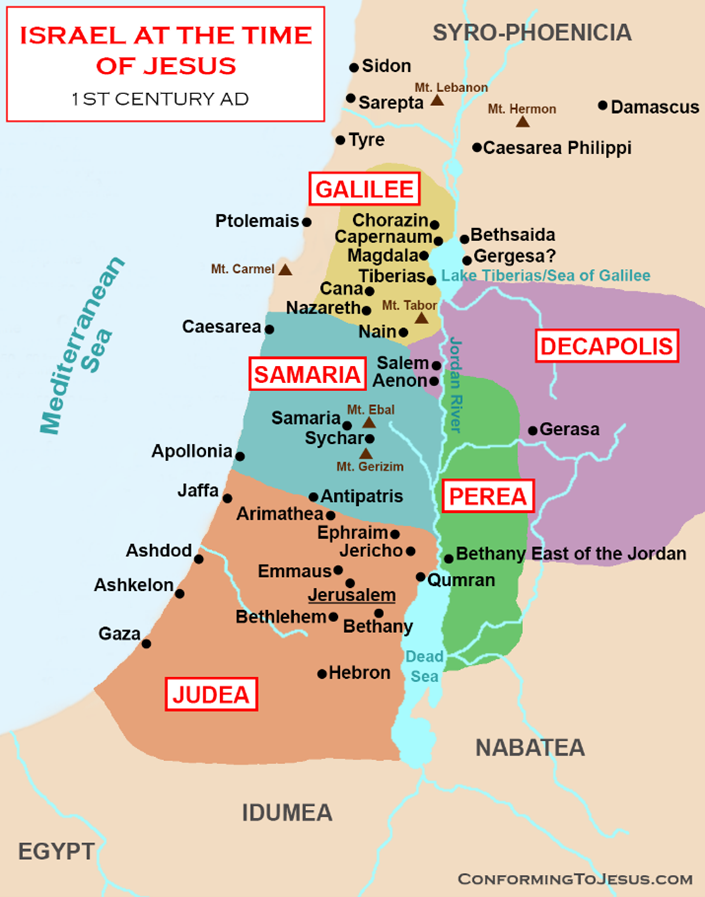
Name: the ancient name of the city is Urusalim which means “city” or “foundation” of Shalem, the Canaanite patron god of the city. Shalem was later associated with the Hebrew word, Shalom, which means peace. This gave way to calling Jerusalem the “city of peace,” which is found many times in the Bible: “Pray for the peace of Jerusalem,” Ps. 122:6 (RSV).
The city is also called “Zion” throughout the Bible. Initially, it referred to a distinct part of the city and later to the whole city and its people. Jerusalem is also called “the Holy City” (Is. 48:2; 52:1), “Salem” (Ps. 76.2), “Mount Moriah,” “Ariel” (Is. 29:1-2), and “City of David.”
Height: The biblical city is spread across two hills. It is limited on the west and south by the Hinnom Valley, and on the east by the Kidron Valley, which separates it from the Mount of Olives. The average altitude of the hills is 2500 feet in the central mountain range. That would explain the pilgrimage Psalms of Ascent; for example, Psalm 122:4a reads: “There the tribes go up.” This would also explain why John (2:13) says that Jesus, traveling from lower Galilee, went up to Jerusalem, as “the Passover of the Jews was at hand.”
A very short history of Jerusalem proper: I include a “short” history in order to aid in the understanding of the city’s many layers of activity. Jerusalem, throughout its long history, has been destroyed twice, besieged, captured, recaptured and attacked countless times. It has been considered holy to the three major monotheistic religions, Judaism, Christianity, and Islam. Our common history goes back to Abraham, our patriarch.
Prehistory: Jerusalem is one of the oldest cities in the world. It has at least 5,000 years of inhabited history. The southeastern hill, known as the City of David, is the most widely accepted site considered to be where permanent settlement began in ancient Jerusalem. There the Gihon Spring attracted shepherds who camped near the water between 6,000 and 7,00 years ago, leaving behind ceramics and flint artifacts during the Chalcolithic, or Copper Age (ca. 4500-3500 BC).
Ancient Period: Around 3000-2800 BC, a small village emerged. The city’s inhabitants at this time were Canaanites who are believed by scholars to have evolved into the Israelites. Around 1000 BC, Saul died, and David became king. According to the Bible, King David conquered Jerusalem, then called Jebus, from the Jebusites, a Canaanite tribe that inhabited Jerusalem, and made it the capital of the United Kingdom of Israel. He reigned for 40 years and was succeeded by his son Solomon, who, around 950 BC, built the First Temple on the spot where it is believed that Abraham brought his son Isaac to be sacrificed. This area is called the Temple Mount. About 920 BC, Solomon died and the United Kingdom split into Israel (north) with its kings, prophets, priests, religious traditions, and into Judah (south) with its Aaronid priesthood. Jerusalem became the capital of the Kingdom of Judah. The 8th century is known as the period of the prophets Isaiah, Amos, Hosea, and Micah. The Kingdom of Israel was conquered by the Assyrians in 722 BC. As a result, Jerusalem was strengthened by the migration of refugees from the northern kingdom.
The First Temple period according to Jewish history ended around 586 BC when Nebuchadnezzar’s Babylonian Empire conquered Judah and Jerusalem, and destroyed Solomon’s Temple and the city. Thus began the Babylonian Exile. In 538 BC, the Persian King Cyrus the Great invited the Jews of Babylon to return to Judah and to rebuild the Temple. The Second Temple was completed and consecrated in 516 BC during the reign of Darius the Great, exactly seventy years after the destruction of the First Temple. The Second Temple period begins in 516 BC with the consecration of the Second Temple and ends in 70 AD with its destruction by Titus’ Roman army.
Hellenistic period 332 BC-63 BC: In 332 BC, Alexander the Great conquered the Persian Empire, and Jerusalem and Judea came under Macedonian control. Alexander died unexpectedly in 323 BC, and by 301 BC, his empire was divided among his generals. For our purposes, the most important generals were Ptolemy and Seleucus. During most of the 3rd century BC, the Ptolemies in Egypt ruled Jerusalem and Judea. During most of the 2nd century BC, the Seleucids to the north ruled it. In 167 BC, Antiochus IV Epiphanes, a Seleucid, outlawed Judaism and dedicated the Jerusalem Temple to Zeus, which sparked the Maccabean Revolt. In 164 BC, Antiochus took back his edict outlawing Judaism, and the Jewish Temple was rededicated to the God of Israel, but the Maccabean Revolt continued. Between 150 and 140 BC, the Maccabees established an independent Jewish kingdom ruled by their descendants, the Hasmoneans. In the following years, the Hasmoneans were able to increase the size of their kingdom by means of territorial expansion.
Roman Period 63 BC-AD 324: In 63 BC, Pompey the Great annexed the Hasmonean kingdom and extended the influence of the Roman Republic over Judea. After a short invasion by the Parthians, backing the Hasmonean rulers, Judea became the scene of struggle between the pro-Roman and pro-Parthian armies, eventually leading to the rise of an Edomite named Herod. As Rome was gaining power, it installed Herod as the King of Judea. He became known as Herod the Great (37 BC-4 BC) and devoted himself to developing Jerusalem and building walls, towers and palaces. He expanded the Temple Mount by doubling its size and rebuilt the temple with the consent of the public. In 31 BC, Octavian defeated Marc Antony and Cleopatra at the Battle of Actium and reconfirmed Herod as King of Judea and increased the size of his kingdom. After Herod’s death (traditionally 4 BC), his son, Archelaus was deposed, and in 6 AD, Judea came under Roman rule as the Province of Judea, although the Herodian dynasty remained client kings of neighboring territories until 96 AD. Rome sent low-ranking governors (prefects) who established their base of administration at Caesarea Maritima. From 26-36 AD Pontius Pilate became the Roman prefect, during which time he ordered the execution of Jesus. In 66 AD there occurred the First Jewish Revolt against Rome which ended in 70 AD with a Roman victory. The Second Temple was destroyed in 70 AD, and the entire city was destroyed in the war. The Second Jewish Revolt, called the Bar Kokhba revolt, against Rome began in 132 AD and was suppressed by the Romans in 135 AD. After this revolt the Emperor Hadrian combined the Province of Judea with the nearby provinces under the new name of Syria Palaestina, replacing the name of Judea. He named the city Aelia Capitolina, and rebuilt it in the style of a Roman town. Jews were not allowed to enter the city under pain of death, except for one day a year, during the holiday of Tisha B’Av, an annual fast day in Judaism, and a day to mourn the destruction of Solomon’s Temple and the Second Temple and other major calamities that have befallen the Jewish people. These measures secularized the city and the ban was maintained until the 7th century.
In 313 AD Constantine issued the Edict of Milan legalizing Christianity. In 324 AD, he established Constantinople (formerly Byzantium) as the new capital of the Roman Empire. In 395 AD the Roman Empire was split into two halves, west and east. The east became the Byzantine Empire. The Byzantine Emperor Justinian reigned from 527-565 AD. In the year 614 AD, the Sassanid Persians overran Palestine, but were repulsed by the Byzantines in 627. The Byzantine conquest did not last very long, for it was precisely during this war that the spread of Islam began. Soon after the death of the prophet Mohammed in 632 AD, Muslims launched conquests into Palestine. Jerusalem surrendered in 638, and Caesarea Maritima fell in 640. In Jerusalem the Muslims transformed the abandoned Temple Mount into a “noble and sacred enclosure” because of its association with Abraham’s offering of his son. They built two monuments on the Temple Mount: The Dome of the Rock and the al-Aqsa mosque. The establishment of Muslim rule in Palestine in the 7th century lasted for centuries, including the Ottoman period which spanned the years 1517-1917. Muslim rule finally ceased with the fall of the Ottoman Empire at the end of World War I. In 1917 after the Battle of Jerusalem, the British Army captured the city. In 1922, the League of Nations at the Conference of Lausanne mandated the United Kingdom to administer Palestine, Transjordan and Iraq. The British withdrew from Palestine in 1948, Israel declared its independence, and the State of Israel was established.
Meaning of Jerusalem within the Bible and in history:
The Biblicist, Massimo Grilli wrote an article on the relationship between the Old and the New Testaments. In it he said:
In terms of the meaning of Jerusalem within the Bible and in history, we must say that the city is indissolubly bound to the presence of God in his temple, and to the Davidic promise. Jerusalem is the compendium, the epitome, of the hopes of Israel: it represents the Law, the Temple, and the fulfillment of the promise of the Land, and constitutes a city intimately united to the history of Israel, as Psalm 312 witnesses: “The Lord swore an oath to David in truth, he will never turn back from it: ‘Your own offspring I will set upon our throne.’ Yes, the Lord has chosen Zion, desired it for a dwelling: ‘This is my resting place forever; here I will dwell, for I desire it’” (vv. 11.13-14). The prophets then gave to Jerusalem a universal and cosmic dimension, with the pilgrimage of peoples to Zion (Is 2:2-4; 60; Zech. 8:22). In the course of history, the promise of God about Jerusalem was put into crisis: the city has endured more than thirty sieges and terrible massacres, including that of Hebrews and Muslims on the part of the Crusades. On the other hand, though, Hebraism has looked upon the city of Jerusalem as a symbol of the perennial promise of God, and hence the dream of restoration (see Jeremiah 32). Linked to this aspect is another [one]; …Hebraism has looked at times to the future, to a restoration of the city beyond its purely terrestrial dimension (Is 2:2; Mic 4:1; Ezra 17:22). In some Hebraic groups, one encounters in this way also the hope of a Jerusalem preserved in heaven, which will be rendered visible only at the end of times…. The Testament of the Twelve Patriarchs affirms that “the saints will rest in Eden and the just will rejoice in the new Jerusalem” (Test. Dan 5:12) …. The heavenly Jerusalem, in opposition to the actual one, appears also in rabbinic writings.
Hence, we can understand that the categories “Jerusalem above” and “Jerusalem below” were not created by Christianity; in reality, these have a rich Jewish background. Judeo-Christianity took up this category of thought and developed it, above all else in Hebrews and Revelation, applying it to the full realization of the kingdom of God instituted by Christ with the Resurrection (Grilli, Quale rapporto tra i due Testamenti? 121-122).
Reflection: For the Jews, Jerusalem is a place of triumph and tragedy. Is this not true for Christians also? What does this city mean to us? Jesus suffers abuse within her walls (e.g., Jn. 18), and He dies outside her walls (Jn. 19:17; Heb. 13:12). But He also rises in Jerusalem victorious over sin and death. It is the place where the God-made-man, who by dying destroyed our death, and by rising restored our life. The “heavenly Jerusalem” will be our home if we remain faithful: “On the victor I will inscribe the name of my God and the name of the city of my God, the new Jerusalem, which comes down out of heaven from my God, as well as my new name” (Rev. 3:12).
In this pilgrimage, we will concentrate primarily, but not exclusively, on the Old City of Jerusalem and on the sites of the Last Supper and of the Passion, Death, Resurrection, and Ascension of the Lord.
Territorially, the modern city of Jerusalem extends far beyond the city of ancient times. We will limit our focus to biblical times and look first at the topography of the Old City beginning with the hills and valleys and then the walls and gates in order to understand our setting for important scenes of Christ’s saving mission. Let’s start with the five hills. The original city began on the (1) southeastern hill called the City of David. This was the city that David captured and made his capital. Solomon expanded the city by building the temple on the (2) Temple Mount, the northeastern hill. Later, under King Hezekiah, the walls were expanded to include (3) the Western Hill and (4) Mount Zion, the southwestern hill. The northern border to the city ran from Jaffa Gate to Lion’s Gate. After the Babylonian exile, the city was reduced to the two eastern hills. By the time of Jesus, the city had expanded and grown larger than it had been in the time of the Old Testament. Although (5) the Mount of Olives was never enclosed in the walls of Jerusalem, it has a prominent role in the city’s history (Stephen J. Binz, Holy Land Pilgrimage).
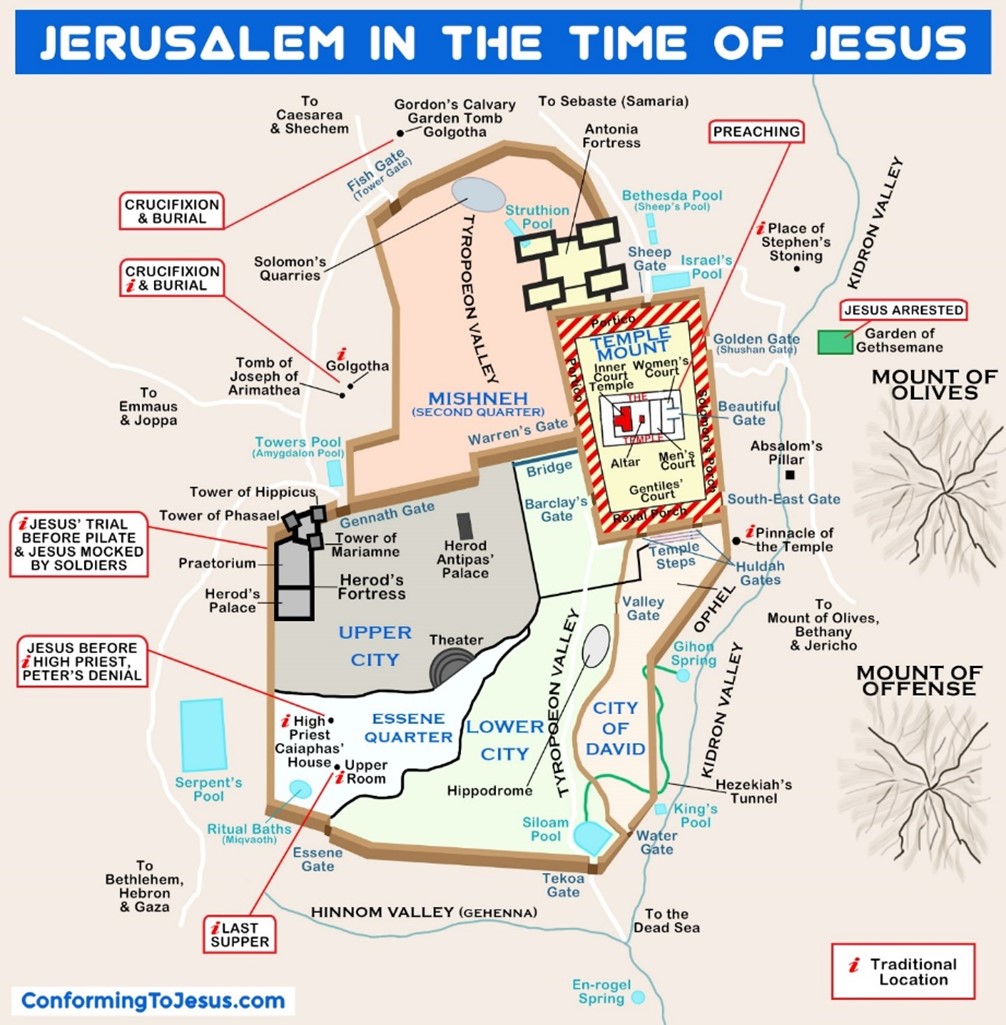
The five hills are separated by the three valleys. The Kidron Valley is located on the north and east side of the city. It separates the walled city from the Mount of Olives. During His final week, Jesus crossed this valley many times, passing from Bethany and the Mount of Olives into the city and back again.
The Central Valley or Tyropoeon Valley or Valley of the Cheesemakers divides the eastern hills of the city from the western hills. At the time of Jesus, the valley was so deep that the western hills were connected to the Temple Mount with bridges. Shops and markets lined the valley with the bridges above.
The Hinnom Valley, also called the Gehenna or Akeldama Valley, runs from the western side of the Old City and meets the Kidron Valley on the southeastern corner. It forms the city’s southern defense. It was here that, in the period of the kings, children were presented as burnt offerings to Molech and the other Canaanite gods (2 Kings 23:10; Jer. 7: 31-34). The Hebrew word “Gei-hinnom, Valley of Hinnom, became, in the Greek New Testament, Gehenna which is described as a place of sin and evil. Because of this, Jesus used the word to describe the opposite of life in God’s Kingdom (Mk. 9:43-48). The valley is also the place where Judas Iscariot took his life. Akeldama, “Field of Blood,” was located in the eastern part of the Valley of Hinnom. The thirty silver pieces, the blood money given to Judas to betray Jesus, were returned by him to the chief priests of the temple who used it to buy potter’s field, a place to bury foreigners (Mt. 27:3-10) (Binz, Holy Land Pilgrimage).
The city has a massive fortification system. The modern walls of the Old City were completed by the Turkish Sultan Suleiman the Magnificent in 1541. The walls of the city were destroyed and restored many times.
The walled city is divided into four “quarters,” named for the dominant ethnic or religious identity of its residents.

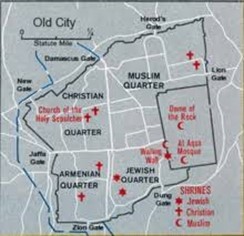
Green: Muslim Quarter (Gold – Temple Mount); Gray: Christian Quarter; Blue: Jewish Quarter adjoining the Western Wall of the Temple Mount; Violet: Armenian Quarter.
On the northeast side is the Muslim Quarter. It includes the Temple Mount with the Dome of the Rock and Al-Aqsa Mosque, the Pools of Bethesda, and part of the Via Dolorosa. To the northwest, the Christian Quarter contains the rest of the Via Dolorosa and the Church of the Holy Sepulcher. To the southeast, the Jewish Quarter, adjoins the Western Wall, which is the holiest place in Judaism. To the southwest, the Armenian Quarter surrounds the Armenian Orthodox Cathedral of St. James (Binz, ibid.)
Now let us take a brief look at the eight gates in the city walls of Jerusalem. Going clockwise around the simple map above, #1 is the Jaffa Gate which leads to the city of Joppa. #8 is the New Gate which opened in 1889 to allow easier access to the Christian Quarter. #7 is the Damascus Gate which begins the north-south road through the city. #6 is Herod’s Gate. It connects the Muslim Quarter with the Arab neighborhoods outside the wall. #5 is Lion’s Gate or St. Stephen’s Gate which leads toward the Mount of Olives, and the walled up #4 Golden Gate is built over the ruins of the gate through which Jesus entered. #3 is the Dung Gate which today leads, from the inside, to the Western Wall and the Jewish Quarter, and, from the outside, leads to the ancient City of David. #2 is the Zion Gate which leads from the Armenian Quarter to the sites on Mount Zion (Binz, ibid.)
Reflection: As we make our way around the city we think of Psalm 48: 13-15: “Go about Zion, walk all around it, note the number of its towers. Consider the ramparts, examine its citadels, that you may tell future generations that this is God, our God for ever and ever. He will lead us until death.” Reading these verses, do we not think about the protective strength that God exercises on behalf of His people, on our behalf?
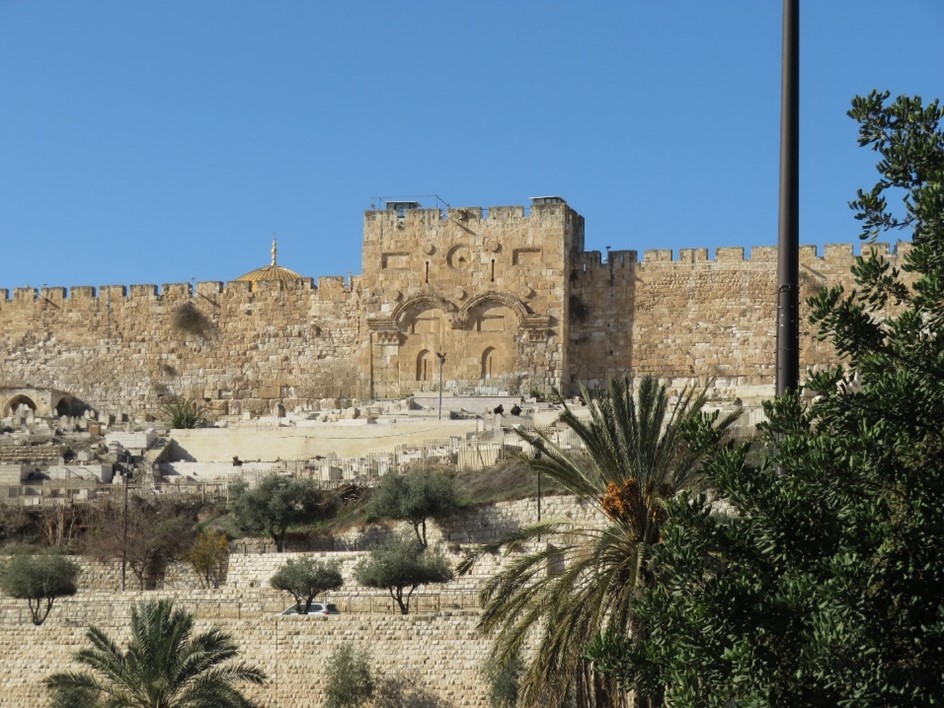
The Golden Gate: Looking over the wall, we get a glimpse of the top of the golden Dome of the Rock, the earliest surviving Muslim monument anywhere in the world.
According to the Jewish tradition, the Messiah (Ezek. 44:1-3) would enter through this gate into the Temple. Archaeologists say that the present Golden Gate was built over the ruins of the gate through which Jesus entered since the present entrance dates to the 7th century. It was probably sealed shut in the 8th century when access to the Muslim section was denied to all unbelievers.
This entrance has been called many things among which are the Golden Gate, the “Beautiful Gate,” the Gate of Mercy, and the Gate of Penance through which the just will enter with their final Judge.
Here, at the Gate called Beautiful, Peter healed the beggar who was crippled from birth (Acts 3:1-10).

The Golden Gate or Double Gate is located at the bottom right of the picture above. On the left side, we see the Dome of the Rock, built by the Muslims in the 7th century on the Temple Mount because of its association with Abraham’s offering of his son, Isaac, and because Muslims consider themselves as inheritors of the faith of Abraham. Muslims saw this shrine as an expression of the triumph of Islam over Judaism and Christianity.
MOUNT OF OLIVES
Let us ascend the Mount of Olives or Mount Olivet which faces Jerusalem on the eastern side of the Kidron Valley. It takes its name from the olive groves that covered its slopes from ancient times. Mount Olivet has been used as a Jewish cemetery for over 3,000 years, because according to Jewish tradition based on Zechariah 14, the Messiah will appear on the Mount of Olives, and the resurrection of the dead will begin there. The tradition also says that the Messiah will descend the Mount of Olives and enter Jerusalem through the Golden Gate.
Jesus was familiar with the Mount of Olives, a place to which He often went. When He would go to Jerusalem, He stayed with His friends in nearby Bethany. He would walk over the hill to Jerusalem each day and then over again back to Bethany at night (Lk 21:37). Often He traveled there with His disciples teaching them on this hill.
As Jesus was making His triumphal entrance into Jerusalem on Palm Sunday, descending the Mount of Olives, He spoke of the future of the city, whose faithlessness caused him to weep (Lk 19:41-44). After this, He entered the Golden Gate.
At the bottom of the Mount’s slope is the Garden of Gethsemane where Jesus was arrested few days after His triumphal entrance.
Finally, at the top of the hill, Luke tells us that Jesus ascended into heaven (Acts 1:6-12).
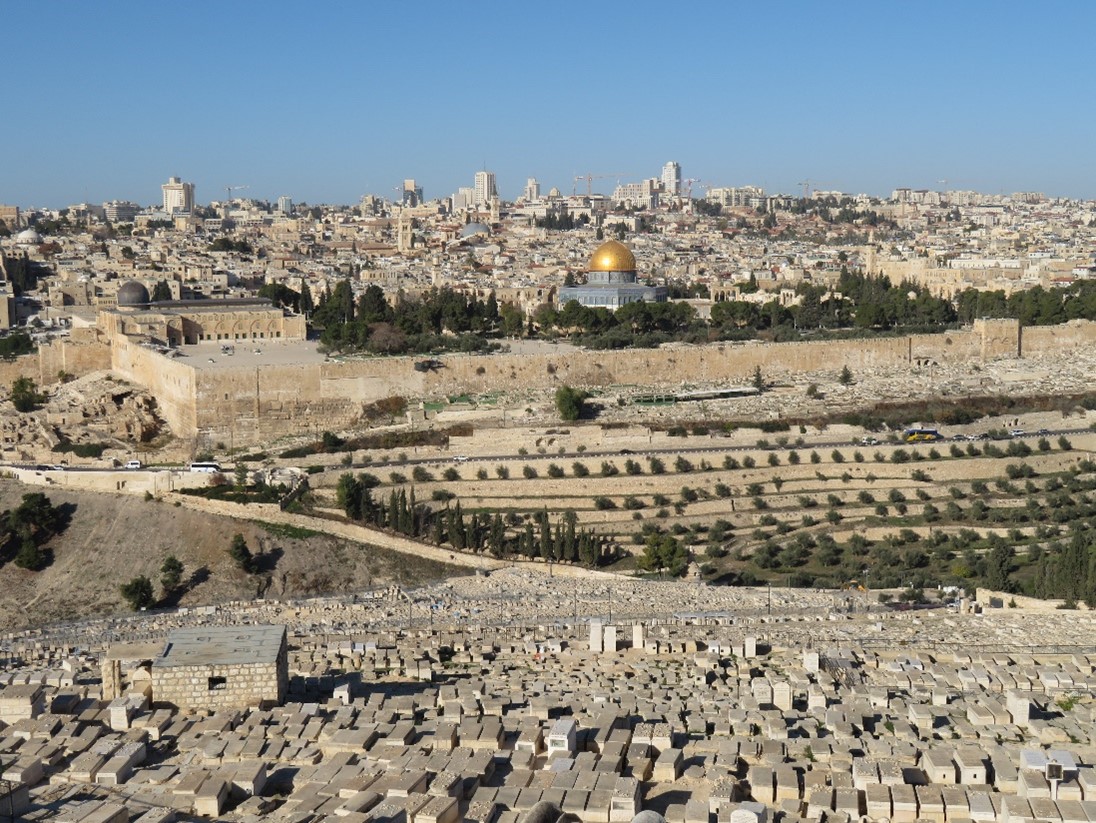
Let us look now at the monuments that memorialize these events on the Mount of Olives.
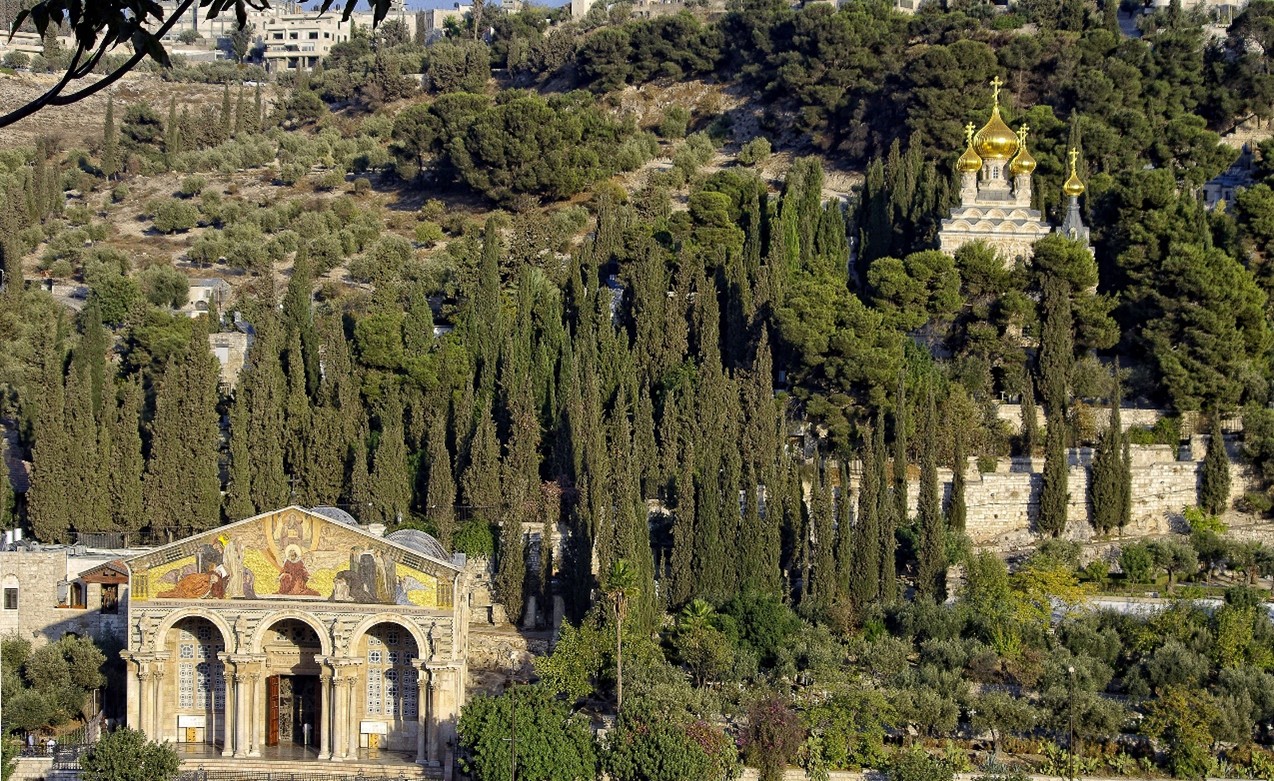
Bethphage is a Christian religious site on the Mount of Olives. In Mt. 21:1-11, we read: And when they drew near to Jerusalem and came to Bethphage, to the Mount of Olives, Jesus sent two disciples, saying to them, “Go into the village opposite you, and immediately you will find an ass tied and a colt with her; untie them and bring them to me… This village of Bethphage commemorates the beginning of Jesus’ entrance into the Holy City. There is an annual Palm Sunday walk into Jerusalem which begins here. A small Franciscan Church (Sanctuary of the Palms) was built in 1883 over the ruins of a Crusader church. Behind the altar of the present church is a fresco depicting Jesus riding on a donkey to the Temple, accompanied by His disciples. Jesus fulfils the prophecy of Zechariah. He is the king riding into Jerusalem, “triumphant and victorious”, yet “humble and mounted on a donkey” (Zech. 9:9-10). The prophet describes this royal ruler by saying that He will banish the elements of war and command “peace to the nations.” Matthew tells us that most of the crowd spread their garments on the road, and others cut branches from the trees and spread them on the road. And the crowds that went before Him and that followed Him shouted, “Hosanna to the Son of David! Blessed is He who comes in the name of the Lord! Hosanna in the highest!” (21:8-9).
Reflection: How is our King like no other king who enters a city triumphantly? What would He have wanted the people to think about Him by entering the city in such a way?
We will now proceed to three more monuments on the Mount of Olives (See map below).
Mosque of the Ascension: The place where Luke tells us that the Lord ascended into heaven is dominated by a building that is now a mosque. I will explain the mosque shortly, but let us first look at the biblical sources for this spot. In his gospel, Luke says concerning Jesus: “Then He led them out as far as Bethany, and lifting up His hands He blessed them. While He blessed, He parted from them, and was carried up into heaven. And they returned to Jerusalem with great joy, and were continually in the temple blessing God (24:50-53). Luke does not give the exact spot where this happened, but it seems that it occurred on Easter Sunday. In his second writing, the Acts of the Apostles (1:9), the Ascension occurs “forty days” after the Resurrection (1:3) somewhere on the Mount of Olives, “which is near Jerusalem, a Sabbath’s day’s journey away” (1:12), or 2000 steps or a half a mile, the maximum distance a Jew was allowed to travel on the Sabbath.

There was a Christian church built here sometime before 392 AD. It was a circular colonnade and open to the sky. In the center of the floor there is a piece of bedrock that marks the place where, according to tradition, Jesus “touched off” to heaven, His last footprints! The Crusaders rebuilt the church in the 12th century, and it was destroyed by the armies of the Muslim sultan Saladin in the fall of Jerusalem in 1187. The chapel was then converted into a mosque. The Muslims added a roof and a mihrab, which is a semi-circular niche in the wall, indicating the direction of Mecca, and, hence, the direction that Muslims should face when praying. This place has become holy to Muslims, who believed that Jesus ascended into heaven, although it is not mentioned in the Qur’an. A second mosque was built nearby for Muslim worship so that Christians could continue to visit the main chapel. Today, the mosque is open to visitors of all faiths.
Reflection: Does the Feast of the Ascension seem bittersweet? After all, Jesus is leaving His disciples, and this time they knew that He was not coming back as He did after the Resurrection. But then we are told that they returned to Jerusalem with great joy, continually blessing God. Why? Because they remembered that Jesus promised the Holy Spirit and that He said: I go to prepare a place for you, that where I am, there you may be also. What is this place like? Eye has not seen, nor ear heard, neither have entered into the heart of man, the things which God has prepared for them that love Him. Jesus is there, waiting for us, too, and by His Holy Spirit, He is here accompanying us as we carry out our religious mission and make our way to Him with songs of joy.
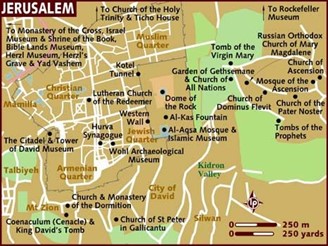
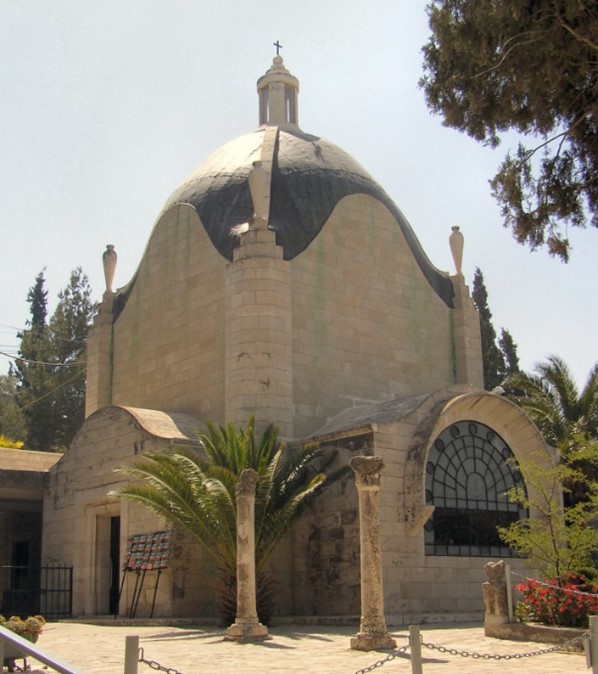
Halfway down the Mount of Olives we see a small chapel called “Dominus Flevit”, which is Latin for “the Lord wept.” It was designed by Antonio Barluzzi in the form of a teardrop – fittingly! The building commemorates Jesus’ lament over the Holy City (Lk. 19:41-44) and His prophecy of the destruction of the Temple (Mt. 23:37-39). He made both of these statements during His approach to Jerusalem from the Mount of Olives.
Here is Matthew’s version of Our Lord’s words foretelling the future destruction of Jerusalem at the hands of Titus and Rome’s Tenth Legion in 70 AD: “O Jerusalem, Jerusalem, killing the prophets and stoning those who are sent to you! How often would I have gathered your children together as a hen gathers her brood under her wings, and you would not! Behold, your house is forsaken and desolate. For I tell you, you will not see me again, until you say, ‘Blessed is He who comes in the name of the Lord.’”
Sitting inside in the chapel and looking through the glass window, we have a perfect view of the Old City where the Great Temple once stood.

Reflection: Can I imagine Jesus weeping over our country or our world?
Going down to the bottom of the Mount of Olives, we reach the area of Gethsemane. Here we find a large basilica, also designed by Antonio Barluzzi, called the Basilica of the Agony or the Church of All Nations. This church was built in 1924 and is located on the traditional site of the Garden of Gethsemane, where Christ prayed, sweating blood before His Passion.
Before we go inside, let us look at the mosaic above the front door. In the triangular space above the front door, we see a mosaic of Jesus in glory offering His sufferings and those of the world to His Father. We are invited to unite all our sufferings to those of Christ, and then we say: “For the sake of His sorrowful passion, have mercy on us and on the whole world.”
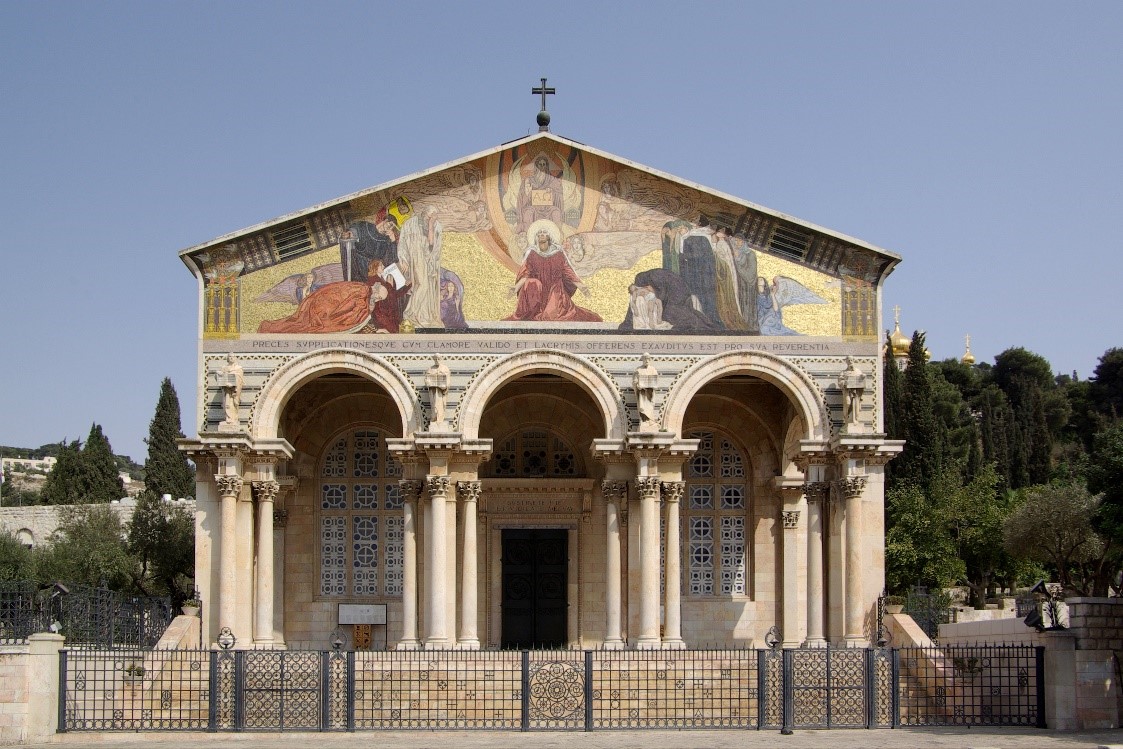
Inside the basilica, there are ceiling representations symbolizing the many nations that donated money for the construction of this building; hence, the name “Church of all Nations.” This church succeeds two others built on this spot in times past: the first one erected between 379 and 384 when Theodosius was Emperor of Constantinople and the second one in the 8th century.
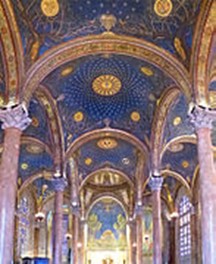
But the most important part of this area we can see and touch; that is, the rock that is preserved in front of the altar – the rock where Christ sweat His blood in agony.


Outside of the church there is a grove of olive trees with gnarled bark and branches. The trees seem very old but, in fact, it was recently discovered that these trees have the same DNA as those of the time of Jesus. So, while the trees we observe above the ground are not from the first century AD, those beneath them could be. The Roman Emperor Hadrian had the grove burned when he destroyed Jerusalem in the mid-second century AD.
This is the place, here in Gethsemane, where Jesus left his sleepy disciples to go and pray to His Father in heaven, and this is the place where He was arrested and taken to the house of Caiaphas.
Reflection:
*Am I watchful and awake in the trials of everyday life?
*Do I try to conform my will to the Will of the Father? Am I holding anything back? I pray for faith, humility and courage to be able to say, “Thy Will be done.”
*Let us unite our sufferings to those of Christ and pray the Divine Mercy Chaplet.
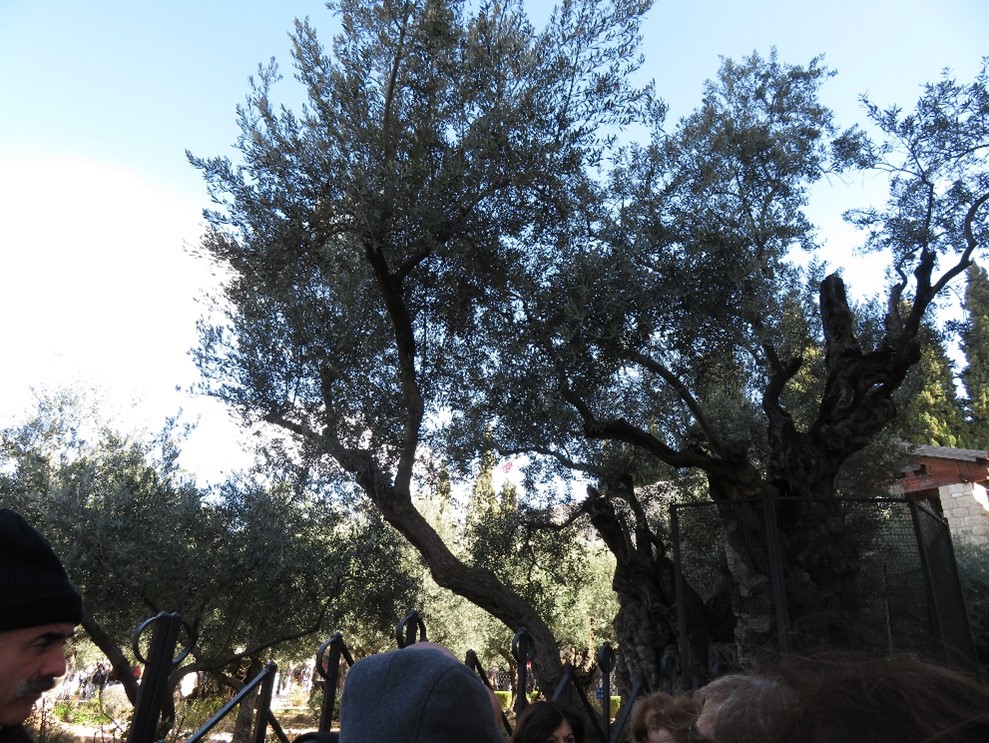

END OF PART I: PILGRIMAGE TO JERUSALEM
